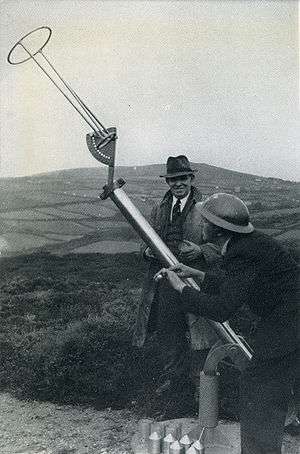Steam cannon
.jpg)

A steam cannon is a cannon that launches a projectile using only heat and water, or using a ready supply of high-pressure steam from a boiler. The first steam cannon was designed by Archimedes during the Siege of Syracuse. Leonardo Da Vinci was also known to have designed one (the Architonnerre).
The early device would consist of a large metal tube, preferably copper due to its high thermal conductivity, which would be placed in a furnace. One end of the tube would be capped and the other loaded with a projectile. Once the tube reached a high enough temperature, a small amount of water would be injected in behind the projectile. In theory, Leonardo da Vinci believed, the water would rapidly expand into vapour, blasting the projectile out the front of the barrel.
The viability of the concept has been explored, with mixed results, by both the television series MythBusters[1] and students at the Massachusetts Institute of Technology.[2]
Age of Steam
Various unsuccessful efforts were made during the age of steam to create working steam machine guns and cannons using methods and technology derived from steam locomotives.
A successful World War II steam cannon was the Holman Projector, which was used to launch explosive grenades into the air to create a defensive barrage against low-flying enemy aircraft.[3] These later steam cannons were fired by rapidly introducing a burst of highly pressurized steam into the chamber behind the projectile, accelerating the projectile up the barrel at a high rate of speed, much like an air gun, only more powerful. The fundamental function of the device was basically the same as a steam engine, only with a projectile taking place of a piston. The Holman Projector was produced by Holman Brothers of Cornwall, who specialised in pneumatic equipment for mining. The first Projectors were powered by compressed air, stored in high pressure cylinders. After a successful defence of the SS Highlander in August 1940, downing two Heinkel floatplanes, there was a demand for more projectors to be fitted to small naval trawlers.[4] As these vessels were steam-powered but had no compressed air system, the Admiralty requested Holmans to develop a steam-powered version of the Projector. With concerns by Treve Holman over the effects of heat on the Mills bomb projectile, a test was arranged where a borrowed council steam roller was used to 'cook' the Projector and projectile at 190 °C for 20 minutes before the projectile was safely fired to 1,000 feet altitude.[5]
See also
- William Murdoch – invented a steam cannon
- Hilton Head Island, South Carolina – site of experimental steam cannon
- Winans Steam Gun
- MythBusters - MythBusters Steam Cannon episode
- Phreatic eruption - Volcanic in origin
Sources
Notes
- ↑ "Episode 55: Steam Cannon/Breakfast Cereal" from the official MythBusters episode guide at the Discovery Channel website
- ↑ "Archimedes's Steam Cannon" on the MIT website
- ↑ Carter, Clive (2001). Cornish Engineering. Camborne: CompAir UK. pp. 81–90. ISBN 0-904040-53-4.
- ↑ Carter (2001), p. 85.
- ↑ Carter (2001), pp. 84–86.
External links
| Wikimedia Commons has media related to Steam cannons. |
- Mr Perkins extraordinary steam gun of 1824 article about an attempt by steam pioneer Jacob Perkins to produce a working steam weapon